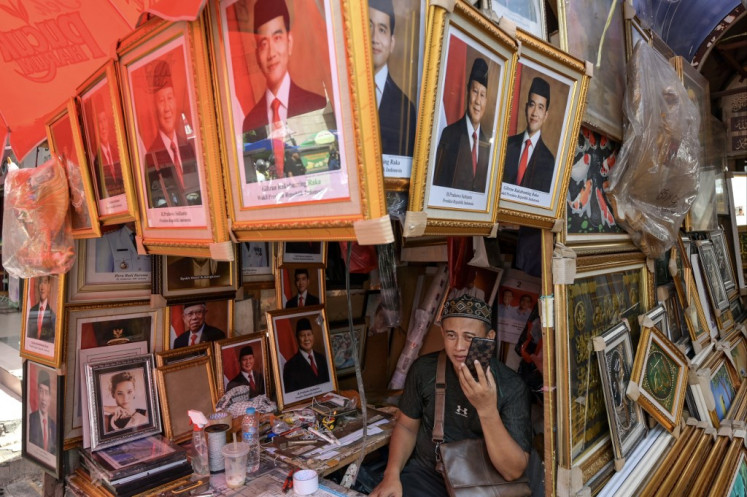Improving government cash management
The government needs to have a good mechanism to manage the gap between those cash receipts and their disbursement timing.
Change Size
 The government needs to have a good mechanism to manage the gap between those cash receipts and their disbursement timing. (Antara/Adwit B Pramono/)
The government needs to have a good mechanism to manage the gap between those cash receipts and their disbursement timing. (Antara/Adwit B Pramono/)
T
he government cash management is the key to sustainable day-to-day government operations. Cash management differs from budget execution since the main focus is not on maintaining the budget ceiling but to ensure the availability of money to pay daily government expenditure.
There are two types of cash that government needs to manage based on their sources. First, the cash from non-financing sources such as tax and non-tax revenue called rupiah murni (RM). Second, the cash from financing sources such as government securities, foreign loans and grants. The government needs to have a good mechanism to manage the gap between those cash receipts and their disbursement timing.
The Finance Minister’s Regulation Number 234/2015 has separated the RM cash management with the loan and grants cash management based on their task units. However, there has been no clear separation for these two in the government bank account structure. Currently, the government applies a general financing system, where expenditures will be covered with all cash available in the State General Treasury Account regardless of the source.
This cash-pool system is affected by the treasury single account mechanism used by the government since 2009. The advantage of this mechanism is that the cash available in the treasury single account can be used to pay all of the spending agencies expenditures with first come first serve basis since all cash are blended in this account. However, since this system is adopted from countries that don’t have a foreign loan financed expenditures such as USA and Australia that has different currency with their main currency, it has two main problems.
The first problem is that funds derived from RM are used to pay expenditures that should be funded by loans or grants. In other words, treasury single account is providing the down payment for projects that should be financed directly by loans and grants. This causes the increase in cash disbursement on the account which may lead to a cash shortage, which in turn leads to the need for treasury notes issuance. If this happened, then the treasury notes that are issued are not because of a “real” cash shortage but because the expenditures that should be financed by foreign loans and grants are paid first by RM.
Another weakness of this cash-pool mechanism is that it provides an incentive for “ineligible backlog” incidence. Ineligible backlog is a down payment fund, paid by RM, that is not replaced by donor with reasons, such as expenses made after the closing date or expenses are not in accordance with the procurement guidelines of the loan and grant agreement.
Therefore, when the donor does not agree to reimburse the RM down payment, then the government will be burdened by that expenditure and must allocate budget for that ineligible expenses. Furthermore, the ineligible backlog incidence can only be noticed after an audit process which means there will be a time lag between the incidence and when the government realizes it.
To overcome these limitations, the government needs to improve their cash management system. This can be done by implementing daily disbursement plan based on funding sources and restructuring the government disbursement account. By improving the daily disbursement plan based on their source of fund i.e. foreign loan and grants, RM or sukuk, the government can reduce the bias of the cash shortage mentioned above. Therefore, the government will have a more accurate planning of cash disbursement and the source of funding for that disbursement.
The next step is restructuring the government account by adjusting it to the source of funds, the Directorate General of Treasury should implement a direct debit procedure on their foreign loan and grant special account. With direct debit, expenditures will be directly paid according to its source of fund.
This is more efficient than the two steps procedure applied currently which is debiting the treasury single account and replacing the fund with foreign loan and grant special account. This policy will reduce the opportunity cost that the government suffered due to RM funds down payment for the foreign loan and grant-based expenditure.
In addition, this policy will support government financing accountability. The ineligible backlog can be suppressed and will not be paid by RM funds directly. The reason is that with direct debit procedure, the funds will be taken directly from the foreign loan and grant special account and the executing agency that receive foreign loan and grant will experience direct consequences of the reimbursement.
This means the executing agency will deal directly with the lenders with ineligible funds and must relocate the proportion of their budget to replace that expenses. With the immediate impact of the ineligible backlog, it will provide incentives for the executing agency to become more disciplined regarding the conformity of spending with the policy on the loan and grant agreement.
Surely this direct debit mechanism is not without its limitations. The first challenge is the internal management capacity of the executing agency to provide an accurate daily disbursement plan for the loan and grant expenditure.
The second challenge is the timing of the cash management system and bank account restructuring especially synchronizing the BIG-eB (Bank Indonesia and Government Electronic Banking) with the SPAN (Sistem Perbendaharaan dan Anggaran Negara) to implement the direct debit process. Implementing the direct debit procedure will result in the transfer of the foreign and loan disbursement authorization from the Directorate of State Treasury Head Quarters to the State Treasury Office spread throughout Indonesia. A reliable information system capacity and continuous development of technical issues that may arise will be the key to the success of this policy.
***
The writer works in Directorate General of Treasury, Finance Mintsry and an alumni of Australian National University. The views are his own.
---------------
We are looking for information, opinions, and in-depth analysis from experts or scholars in a variety of fields. We choose articles based on facts or opinions about general news, as well as quality analysis and commentary about Indonesia or international events. Send your piece to academia@jakpost.com.









